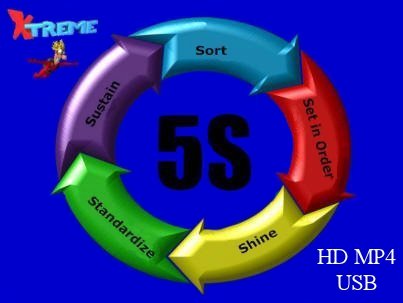5S Lean Manufacturing Assessment
5S Lean Manufacturing :
Test for 5S Lean Manufacturing training video. Fifteen questions about Set-in-Order, Standardize, Sort, Shine, and Sustain.
5S Lean Manufacturing test details:
( 15 Questions )
Test for 5S Lean Manufacturing training video. Fifteen questions about Set-in-Order, Standardize, Sort, Shine, and Sustain.
Are you new to 5S Lean Six Sigma? Below is an introduction to the two manufacturing methodologies and their synergies.
5S Lean Six Sigma
What is the relationship between Lean Manufacturing, 5S, and Six Sigma?
Lean manufacturing, 5S, and Six Sigma are methods. They aim to improve efficiency, reduce waste, and enhance quality in an organization. Though they seem separate, they work together to achieve operational excellence.
Lean manufacturing aims to reduce waste and increase value in production. One tool in Lean is the 5S method. It stands for Sort, Set in Order, Shine, Standardize, and Sustain. 5S is about organizing the workplace for efficiency, cleanliness, and standardization. This method creates a visual, organized workspace. It helps find inefficiencies and improvement opportunities.
On the other hand, Six Sigma is a data-driven method. It reduces process defects and variations. It aims to find and fix the causes of errors. Using it improves the quality and consistency of the output. Six Sigma uses stats to improve processes and cut defects. It boosts customer satisfaction and saves costs.
The relationship between Lean, 5S, and Six Sigma lies in their complementary nature. While Lean aims to streamline processes and reduce waste, 5S is a method to organize the workplace. It makes it easier to apply Lean principles. Meanwhile, Six Sigma complements Lean and 5S. It provides tools and techniques to measure and analyze process variations. Implementation leads to continuous improvement and waste reduction.
Organizations can integrate these methods by first using 5S. It will standardize and organize the work environment. 5S is the basis for Lean principles, like just-in-time production and continuous flow.
Like the 'Standardization' part of 5S, Six Sigma aims to reduce variation.

At the same time, the organization can use Six Sigma tools. They can analyze data, find defect causes, and improve processes. Doing so boosts quality and consistency.
In conclusion, Lean Manufacturing, 5S, and Six Sigma are synergistic and integrated. Using these methods together can create a robust framework. A framework to continuously improve, cut waste, and boost quality in an organization. By combining the strengths of each approach, businesses can excel. They can also gain a competitive edge in today's fast-changing market.
Published:

